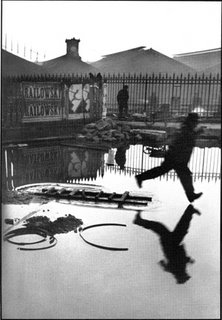I had the opportunity recently to use four of the new Leica M mount "ZM" lenses from Carl Zeiss, Oberkochen. The guy who made the oppportunity possible had his Zeiss dealership yanked out from under him and is no longer associated with the brand, even after he'd gone to considerable trouble to skilfully promote that brand and its products, so I'm going to have to figure out some other way to repay him. (By the bye, this was neither a kind nor a smart move on Zeiss's part, given my friend's expertise and influence. I might even go so far as to assume it was a bit of a nasty business, or at least had a bit of that feel to it; but then, we all know that hidebound, centuries-old companies—would it be hideously xenophobic to say "especially German ones"? My experience is limited—can be as cantankerous to deal with as superannuated battle-axe maiden aunts. Watch yer topknot, fellow travelers.)

Of the four lenses, the 50mm ƒ/2—its official title is "Zeiss Planar T* 2/50 ZM"—was not the glamor lens, so I used it the least and it's taken me a while to catch up to it. It is indeed somewhat un-flashy in nature. I do think it's permissable—or at least not wholly self-indulgent—to write about it, because it is a digital lens now too: it fits on the Epson RD-1 with the same angle of view as a 75mm on 35mm, and also on the hot new Leica M8, where it assumes the angle of view of a 65mm on 35mm—short teles in both cases. It can also be used on a variety of film cameras, including all M-mount Leicas; several Voigtländers, including the R3A and R3M, which are the ones that have 1:1 finders; and also on its own companion "Zeiss Ikon" [sic], the ill-named new super-RF that is the result of a collaboration between Zeiss and Cosina. (This lens is also fabricated by Cosina, for Zeiss, under license.)
It sometimes happens in the world of high-end audio—another locus of unremitting and even counter-productive connoisseurship—that stereo systems most valued by "deep" connoisseurs aren't immediately terribly impressive to neophytes. The reason is that they aren't designed to go for cheap thrills and superficial appeal. To satisfy the high-strung "golden ears" of the expert, they need to achieve hyper-competence within a framework of carefully adjudged balance, with no particular property spotlit or disguised. That description also applies to what I've come to like in lenses.
I mentioned earlier that I have distinct tastes and preferences. To name just a few of these: I tend to like lenses that are optimized for sharpness across the entire frame, as opposed to concentrating their best sharpness in the center of the field; that are optimized for a taking distance of less than infinity (the traditional value is 50•ƒ, which is fine); that do not distort more than, say, 1%; that tend to equalize their performance up and down the aperture range, as opposed to having a more distinct optimum aperture at the expense of the extremes; that have a marginal amount of low-level veiling glare (why? It can serve to, in effect, "pre-expose" the lowest shadow values with black-and-white film) but as little ghosting as possible; that "masks" micro-resolution with robust large-structure contrast, which I think looks a little more natural than lenses with the ultimate in resolution (anyway, it goes better with my favorite films, none of which are high-resolution). Those are a few of the major ones.
And then there's
bokeh. The term is a general Japanese word that roughly translates to "fuzzy," and that has a number of different connotations in Japanese. Applied to lenses it merely means optical blur, or the blur of imaged objects away from the plane of best focus (as opposed, of course, to blur caused by either the subject or the camera moving). Technically, there is no "good" or "bad" bokeh. Subjectively, there is, but it's a matter of taste as to which is what. Some people don't care about bokeh; I do. Some people don't take pictures with appreciable amounts of bokeh in them; I do. Some people just don't look at it; I do. Some people have catholic tastes and are accepting of various types of blur rendering; I'm not one of them.
You also can't really generalize about the bokeh of any one lens. Well, you can, but only in the way that one or two MTF charts describe a lens's behavior—pretty well as far as it goes, but in no way is it a
complete description. Bokeh changes with aperture, focus distance, which side of the plane of focus the imaged object is on, and how far the imaged object is from the plane of best focus, and what the imaged object looks like (mainly, but not exclusively, in terms of tonal values and contrast). This describes an effectively infinite range of possible conditions, meaning that all tests are representative and all descriptions are shorthand approximations.
The kind of blur rendering I like in a lens can be vaguely described as the soft "bright-core" type, but soft in the sense of cloudlike rather than fuzzy, resembling lenses from before, say, the 1960s or early '70s, or whenever it was that overcorrected spherical aberration became the norm.
I haven't used every 50mm that exists, but I've tried about 50 of them now and have owned more than 15...and that's more than most people have tried, you've got to admit. What follows is only a provisional decision, and I don't want to be held to it absolutely. Neither, for reasons enummerated earlier, do I want to have to defend my thesis in a court of opinion or hold verbal prizefights with other self-appointed experts. However, I think that (for me, personally, subjectively, given my tastes and values in terms of connoisseurship...you've got all that already, right?), the Zeiss ZM 50mm ƒ/2 is the new winner. It takes pride of place as the best 50mm I know of. I'd have to use it more to be sure, but it looks that way.
I was suprised by this. In construction, it is simple, and resembles (but is not identical to) another of my very favorite 50s, the Konica Hexanon-M 50/2. But its design also resembles some lenses I don't like very much. Also, I must say I'm surprised to like a
Zeiss 50 quite as much as I like this one...I don't normally care for Zeisses (in fact, a couple of the weak points of the Contax Planars were too glaring for me to live with, and were what drove me to Pentax, years ago).
I can tell you that if I shot with the Epson RD-1 or the Leica M8, this would be my short tele (in my world, the shorter your short tele, the cooler you are). And if you care about a) great lenses in general and 50s in particular, b) film cameras, and c) rangefinders, you are three, three, three times a minority amongst photographers. But in case you care, this Zeiss is a very pleasant surprise—a bit of a hidden treasure, I think.
If you own this lens and have pictures taken with it posted online, please leave links in the comments—I'd be interested to see some of what you're doing with it.
This is the third of three related posts, in descending order (anti-blog style)—continuing from the two posted directly above.Posted by: MIKE JOHNSTON








































